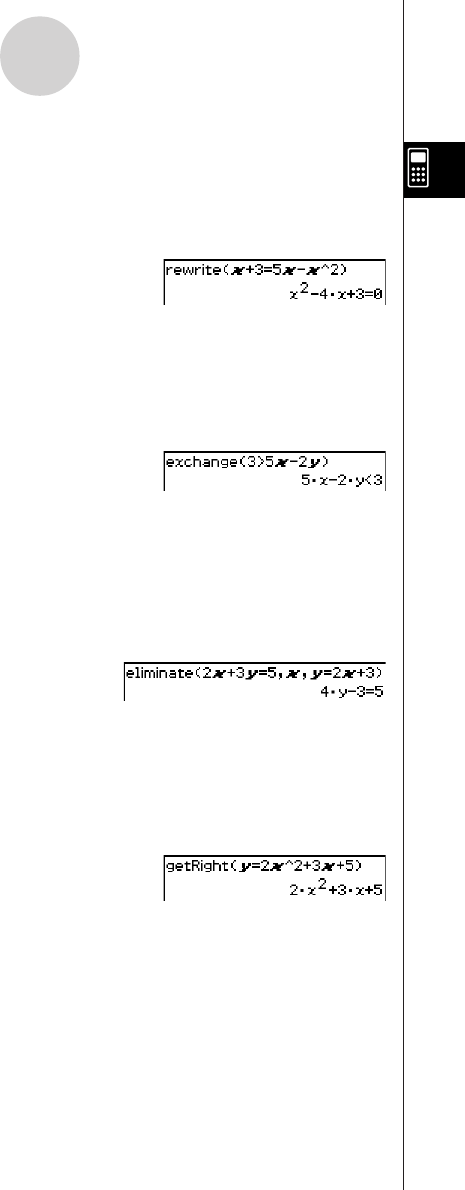Calculator User's Guide
Table Of Contents
- Getting Ready
- Contents
- About This User’s Guide
- Chapter 1 Getting Acquainted
- Chapter 2 Using the Main Application
- 2-1 Main Application Overview
- 2-2 Basic Calculations
- 2-3 Using the Calculation History
- 2-4 Function Calculations
- 2-5 List Calculations
- 2-6 Matrix and Vector Calculations
- 2-7 Using the Action Menu
- 2-8 Using the Interactive Menu
- 2-9 Using the Main Application in Combination with Other Applications
- 2-10 Using Verify
- Chapter 3 Using the Graph & Table Application
- Chapter 4 Using the Conics Application
- Chapter 5 Using the 3D Graph Application
- Chapter 6 Using the Sequence Application
- Chapter 7 Using the Statistics Application
- 7-1 Statistics Application Overview
- 7-2 Using List Editor
- 7-3 Before Trying to Draw a Statistical Graph
- 7-4 Graphing Single-Variable Statistical Data
- 7-5 Graphing Paired-Variable Statistical Data
- 7-6 Using the Statistical Graph Window Toolbar
- 7-7 Performing Statistical Calculations
- 7-8 Test, Confidence Interval, and Distribution Calculations
- 7-9 Tests
- 7-10 Confidence Intervals
- 7-11 Distribution
- 7-12 Statistical System Variables
- Chapter 8 Using the Geometry Application
- Chapter 9 Using the Numeric Solver Application
- Chapter 10 Using the eActivity Application
- Chapter 11 Using the Presentation Application
- Chapter 12 Using the Program Application
- Chapter 13 Using the Spreadsheet Application
- Chapter 14 Using the Setup Menu
- Chapter 15 Configuring System Settings
- 15-1 System Setting Overview
- 15-2 Managing Memory Usage
- 15-3 Using the Reset Dialog Box
- 15-4 Initializing Your ClassPad
- 15-5 Adjusting Display Contrast
- 15-6 Configuring Power Properties
- 15-7 Specifying the Display Language
- 15-8 Specifying the Font Set
- 15-9 Specifying the Alphabetic Keyboard Arrangement
- 15-10 Optimizing “Flash ROM”
- 15-11 Specifying the Ending Screen Image
- 15-12 Adjusting Touch Panel Alignment
- 15-13 Viewing Version Information
- Chapter 16 Performing Data Communication
- Appendix

20050501
2-7-41
Using the Action Menu
uu
uu
u rewrite
Function: Moves the right side elements of an equation or inequality to the left side.
Syntax: rewrite (Eq/Ineq/List [
)
]
• Ineq (inequality) includes the “⫽” (not equal to) relational operator.
Example: To move the right side elements of x + 3 = 5x – x
2
to the left side
Menu Item: [Action][Equation/Inequality][rewrite]
uu
uu
u exchange
Function: Swaps the right-side and left-side elements of an equation or inequality.
Syntax: exchange (Eq/Ineq/List [
)
]
• Ineq (inequality) includes the “⫽” (not equal to) relational operator.
Example: To swap the left-side and right-side elements of 3 > 5x –2y
Menu Item: [Action][Equation/Inequality][exchange]
uu
uu
u eliminate
Function: Solves one equation with respect to a variable, and then replaces the same
variable in another expression with the obtained result.
Syntax: eliminate (Eq/Ineq/List-1, variable, Eq-2 [
)
]
• Ineq (inequality) includes the “⫽” (not equal to) relational operator.
Example: To transform y = 2x + 3 to x =, and substitute the result into 2x + 3y = 5
Menu Item: [Action][Equation/Inequality][eliminate]
uu
uu
u getRight
Function: Extracts the right-side elements of an equation or inequality.
Syntax: getRight (Eq/Ineq/List [
)
]
• Ineq (inequality) includes the “⫽” (not equal to) relational operator.
Example: To extract the right side elements of y = 2x
2
+ 3x + 5
Menu Item: [Action][Equation/Inequality][getRight]










